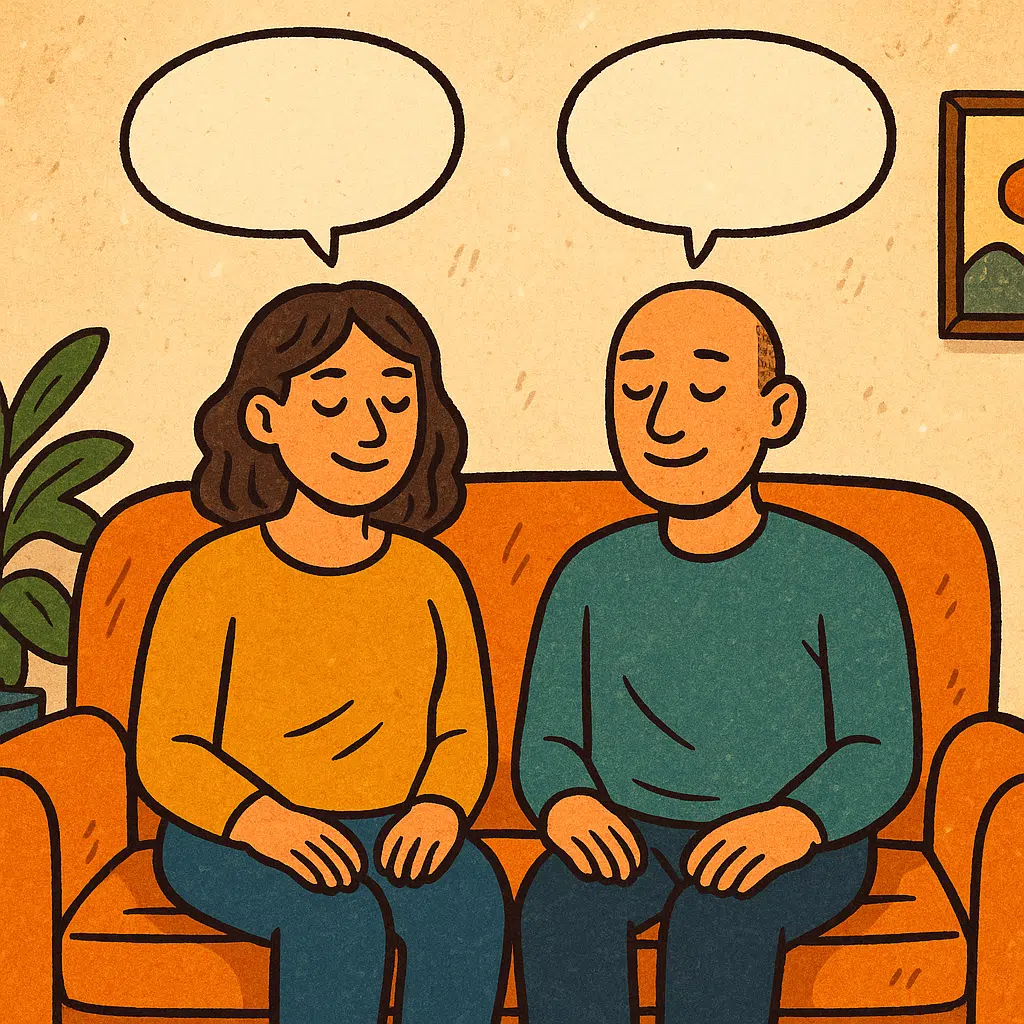Why Shared Silence Builds Connection
Charlotte Stone July 23, 2025
The insight that shared silence builds connection is reshaping how we bond. Emerging research reveals that quiet presence—not conversation—is becoming the new marker of intimacy.

The Science Behind Shared Silence Builds Connection
1. Research Confirms the Quiet Angle
A groundbreaking 2024 study in Motivation and Emotion examined “intimate sounds of silence” in couples. Intrinsically motivated shared silence—quiet moments chosen for closeness—enhanced relationship satisfaction, emotional need fulfillment, and positive mood.
Another set of studies by the University of Reading found that couples sharing silence mindfully reported deeper emotional intimacy and peacefulness—not awkwardness. In contrast, hostile silence (the ‘silent treatment’) led to tension.
2. Psychological Need Fulfillment
Silence in connection taps into two essential human needs: autonomy and belonging. The “dependency paradox” shows feeling secure with someone doesn’t reduce independence—it enhances it when leveraged through mindful silence.
Why Shared Silence Builds Connection in Today’s World
In an era dominated by relentless digital noise, constant messaging, notifications, and virtual presence can exhaust our mental and emotional networks. The always-on culture of social media, emails, and instant communication often leaves little room for genuine human connection. Intentional silence offers a powerful antidote—a refuge where individuals can step away from the chaos of screens and reconnect with themselves and others on a deeper level. Practices like meditation, mindfulness, and breath-aligned silence, often guided by apps or in-person sessions, provide structured ways for couples and communities to rediscover non-verbal forms of communication.
These moments of quiet foster presence, allowing partners to tune into subtle cues—eye contact, body language, or simply the shared rhythm of breathing—that are often drowned out by digital distractions. By creating space for this intentional pause, couples can rebuild trust, empathy, and intimacy, forging bonds that transcend the superficial exchanges of texts or emojis. This “digital detox” effect not only rejuvenates personal connections but also cultivates a sense of inner calm, making room for more meaningful interactions in a world that rarely slows down.
Normalizing Quiet on Public Platforms
The cultural shift toward embracing silence is gaining momentum, with public figures amplifying its value in today’s fast-paced society. Celebrities like Valerie Bertinelli have openly championed the beauty of shared stillness. On The Drew Barrymore Show, Bertinelli described comfortable silence as “heaven,” emphasizing how these moments of quiet connection can feel profoundly grounding. Her candid endorsement reflects a broader trend where influential voices are normalizing silence as a form of modern social validation. From wellness influencers promoting mindfulness retreats to public figures sharing their experiences with unplugging, the act of embracing quiet is being celebrated as a radical counterpoint to the constant chatter of online platforms.
This growing acceptance is evident in the rise of silent meditation events, sound baths, and even “quiet hours” in workplaces and social spaces, where people are encouraged to disconnect and simply be. By highlighting the joy of shared stillness, these platforms are helping reframe silence not as awkward or empty, but as a powerful tool for building authentic connections in an increasingly noisy world.
Benefits of Shared Silence Builds Connection
| Benefit | Description |
|---|---|
| Emotional Safety | Quiet togetherness creates a sense of ease and mutual trust. |
| Space to Reflect | Silence lets both partners think before responding, reducing reactive conflict. |
| Non-Verbal Bonding | Eye contact and touch during silence foster deeper connection than words can convey. |
| Stress Reduction | Conscious quiet lowers cortisol and helps with anxiety management. |
| Respects Personality | Especially helpful for introverts—it avoids conversation fatigue and honors personal rhythms. |
Practical Guide: How Shared Silence Builds Connection in Daily Life
1. Schedule Silence Moments
Block short daily intervals (5–15 min) for mutual quiet—no devices, no distractions. Whether sipping tea before bed or relaxing together, those moments speak volumes.
2. Try Breath Synchronization
Sit comfortably, close your eyes, and match breathing rhythms. This simple exercise aligns heart rates and creates subconscious emotional resonance.
3. Lead Silent Activities
- Read side-by-side
- Cook while playing soft music
- Go for a walk without talking
Shared presence in focused tasks drives connection without words.
4. Distinguish “Good Silence” from “Silent Treatment”
Good silence is mutual and comforting. The silent treatment is cold and blaming. Label your silence: “Let’s just sit quietly for a bit,” signals safe, shared space.
5. Reflect Afterward
Invite reflection—“That silent walk felt peaceful”—to reinforce the bonding effect and validate the experience.
Emerging Trends in Shared Quiet
Couples are increasingly seeking shared silence to deepen their connection in a noisy world. New tools and spaces are emerging to support this mindful trend.
Silence-Focused Tech
Apps like Synchronous and PauseTogether offer guided silence sessions with ambient sounds or timed pauses, helping couples disconnect from digital noise and focus on presence. Some integrate wearables to suggest optimal moments for shared quiet, fostering mindfulness even when apart.
Retreats & Hotspots
Silent couples’ retreats are gaining traction, offering activities like forest bathing or silent hikes in serene locations like Tuscany or the Pacific Northwest. Urban co-working cafés are introducing “silent zones” with noise-canceling features for distraction-free connection. Some venues even host “silent date nights,” encouraging non-verbal bonding in calming settings.
Challenges & How to Overcome Them
- Awkwardness at First:
Modern life conditions us to fill silence with chatter. Lean in—initial discomfort fades with consistency. - Partner Misalignment:
If one partner needs more talk, balance silence with check-in conversation. Silence isn’t avoidance—it’s alternative connection. - Miscommunication Risk:
Clearly define silence times to avoid misinterpretation. “This is a pause, not a punishment” helps maintain trust.
Real-Life Examples: Shared Silence Builds Connection
- Valerie Bertinelli & Melissa Peterman luxuriated in “comfy” silence on live TV—“it’s heaven!” they agreed.
- A couple reported daily silent breakfasts boosted mutual ease. No words needed—they just were together.
- Breath sync sessions: partners report feeling “more attuned” than after any verbal check-in.
Final Thoughts
The rise of remote work, pandemic isolation, and digital overwhelm has made meaningful presence rare. That’s why shared silence builds connection matters more than ever—a quiet revolution in how we bond.
Start small. Schedule five-minute evening silences. Try breath alignment. Let silence become your space of belonging, mutual respect, and deeper intimacy.
Takeaway
- shared silence builds connection by fulfilling autonomy and belonging.
- It brings reduced stress, enhanced emotional attunement, and nonverbal bonding.
- Emerging trends—from apps to retreats—are making silence intentional and accessible.
Prioritize quiet. Your next bond-strengthening moment might just be comfortably unspoken.
References
**Weinstein, N., Nguyen, T.-V., Adams, M., & Knee, C. R. (2024).** Intimate sounds of silence: Its motives and consequences in romantic relationships. Motivation and Emotion.. vice.com
Scientific American. (2025, February). The Psychology of ‘Shared Silence’ in Couples.
https://www.scientificamerican.com/article/the-psychology-of-shared-silence-in-couples/
Cambridge University Press. (2024, May). Quiet environments and the intentional practice of silence toward a new perspective in the analysis of silence in organizations. Industrial and Organizational Psychology.
https://www.cambridge.org/core/journals/industrial-and-organizational-psychology/article/quiet-environments-and-the-intentional-practice-of-silence







